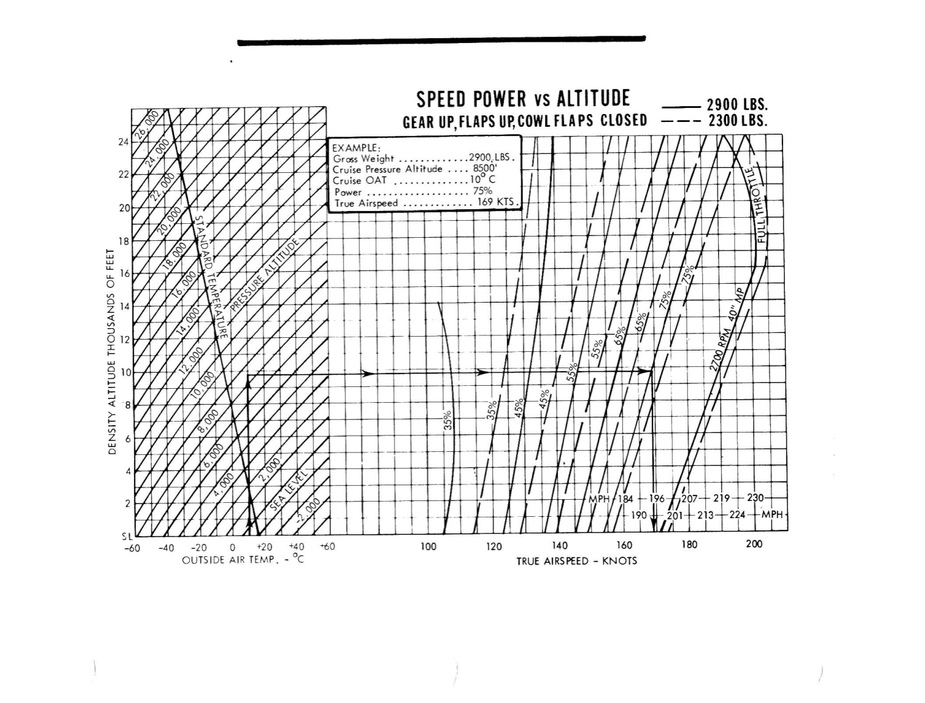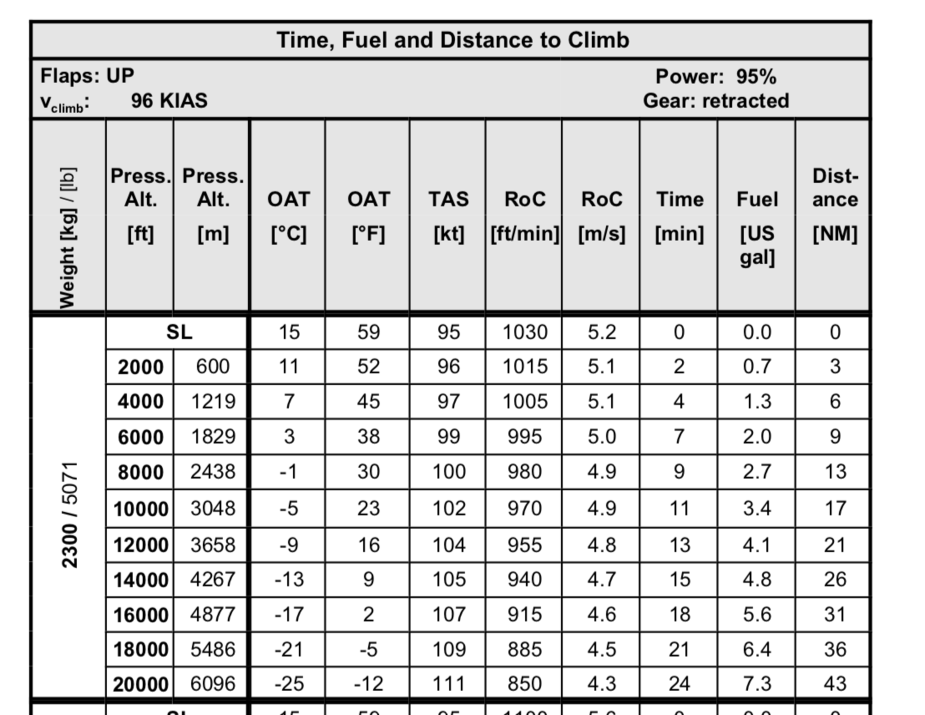Peter wrote:
The Panthera’s 160 is IAS, not TAS. The difference is huge,
Oh, I did not see that. IAS is totally irrelevant when it comes to performance so I tend to overlook it when someone puts it in this context… Yes, 175 KTAS @ 9.6 GPH is not too shabby. Wonder if it does that with the bigger engine they want to put as well…
https://www.panthera-aircraft.com/technical-data
So this would correspond pretty much to their economy cruise setting only they claim this speed in FL120…
So let’s see: At 54 USG fuel capacity and 9.6 GPH that is a realistic 4 hours of range at that speed, which would make about 700-750 NM range. They claim 1000 NM at 155 kt but fail to give the power setting and fuel flow for that, probably 45% or so. Only who will fly such a fast airplane so slow…
For the larger engine I find 54 USG total fuel available very few. Economy cruise is at 12 GPH and best power cruise at 15 GPH, yet they claim only a 5 kt difference. I guess these are wishful thinking figures or has a Panthera actually flown with an IO540 yet? In any case, that is 2.5 to 3.5 hrs of endurance which translates into 500 NM with the 195 kt cruise. A standard Ovation has almost double the fuel capacity standard (102 USG or 130 with Monroys) and is about as fast as the Panthera but will fly up to 10 hours at 185 kts.
What would make this plane worthwile would be if they finally decided to put a Diesel to it. But I suppose that won’t happen.
They show 173 TAS @120 @ 65% for the experimental version with 210 horses.
That looks slightly better than a Mooney 231 …

IAS is totally irrelevant when it comes to performance
We have had several passionate debates on this one  I would argue that IAS is the true measure of performance. For example a plane stalls at the same IAS regardless of altitude and temperature. TAS is good too for practical purposes but you need to specify the altitude and the temperature otherwise it is meaningless (and most aircraft specs omit these extra bits, to make the figures look good).
I would argue that IAS is the true measure of performance. For example a plane stalls at the same IAS regardless of altitude and temperature. TAS is good too for practical purposes but you need to specify the altitude and the temperature otherwise it is meaningless (and most aircraft specs omit these extra bits, to make the figures look good).
has a Panthera actually flown with an IO540 yet?
They told me they have one IO540 model flying, but I didn’t ask for perf data. It’s a very good point about the fuel tank size, since “range is the best speed mod”. However, it is often said by so many pilots that they won’t fly beyond their bladder, so maybe this is not so relevant?
Peter wrote:
For example a plane stalls at the same IAS regardless of altitude and temperature. TAS is good too for practical purposes but you need to specify the altitude and the temperature otherwise it is meaningless (and most aircraft specs omit these extra bits, to make the figures look good).
It is really easy Peter.
IAS refers to operating speeds and to aerodynamics.
TAS is what is needed for any kind of flight planning and performance calcs.
I had the same discussion with the people of a rather popular flight planning program which was brilliant in the low altitudes but got really weird in the uppers primarily because none of them had ever flown over 3000 ft or so. Comparing performance, IAS is totally meaningless, only TAS counts.
I don’t think that any manufacturer would ever use IAS as it is forcibly a lot smaller than TAS. If anything, they will give TAS in MPH because the figure is larger than KTS but thankfully also that has stopped more or less in the last few decades.
Sir_Percy wrote:
That looks slightly better than a Mooney 231 …
The 231 of course has a Turbo so fuel flow should be rather high.
Well, it would be absurd if a computer modelled airplane like the Panthera should be slower than a 50 year old airplane designed on a drawing bord. But unfortunately in very many cases that is what happens. But there is no doubt, the Panthera is out to top Mooneys in efficiency for a SEP using Avgas. IF it ever gets cetified.
Peter wrote:
I would argue that IAS is the true measure of performance.
I can’t agree with that. Picking the closest POH (C172S) it shows, for example, that when you go from FL 0 to FL120 TAS at 65% power goes from 108 to 120 knots. At the same time IAS goes from 111 to 103 knots — all at the same fuel flow. So measuring performance using IAS seems rather pointless as even with the same power setting it is far from constant with changing altitude.
Mooney_Driver wrote:
IAS refers to operating speeds and to aerodynamics.
TAS is what is needed for any kind of flight planning and performance calcs.
IAS is directly related to performance in a number of areas, not least calculating cruise climbs, landing distances, take-off distances, etc.

When looking for range, ignore that table from Section 5 – PERFORMANCE of an AFM at your peril. Performance is far more than just a speed/distance/time calculation for the cruise.
Doesn’t IAS reduce with increasing altitude because the non-turbo engine is losing power?
Dave_Phillips wrote:
IAS is directly related to performance in a number of areas, not least calculating cruise climbs, landing distances, take-off distances, etc.
For those factors you are right of course. All of those are aerodynamic however, basically all the V-speeds and so on. Yes, of course that is part of the performance part and needs to be observed.
My argument comes from the flight planning side, where IAS has very few if any use. Looking at how to set up a performance profile for any airplane, you basically need
Time, fuel and distance to climb
Cruise Tables (TAS/FF in connection with weight if the airplane is big enough)
Time, fuel and distance to descend
The table you quote indicates the climb speed in IAS, which is absolutely correct but then gives the planning speeds in TAS. With that table you have the choice to either implement the time and distance figure or have the flight planner calculate those itself on the base of TAS and ROC/D. Most planners I know use time and fuel for climb and descent. That table however is one of the best I’ve come across as it gives all the information, most small planes with older manuals only give ROC/D and IAS which means you have to calculate the rest yourself which very few people bother to do correctly.
What the issue is with IAS with regard to comparing airplanes e.t.c. there it is quite useless as all the relevant information is TAS. Particularly in the lands where people never fly higher than 2000 ft, a lot of people don’t make this distinction, because IAS and TAS are that close, they get away with it. A large flight planning product for years only used IAS without telling anyone (they just marked it “Speed” until some people bought it who were regularly flying in the Alps and noticed that something was seriously wrong). Ever since, I am trying hard to make this distinction whenever IAS is used in such a relation. How fast a particular type flies should always be expressed in TAS.
Peter wrote:
Doesn’t IAS reduce with increasing altitude because the non-turbo engine is losing power?
No! See, that is exactly what I am talking about.
Climbing speed in IAS is constant because it will provide your wing with the optimum lift vs speed ratio or at least with the one the manufacturer has used for it’s tables, so if you want to get the figures in the manual, that is what you use. Any V-Speed is IAS forcibly as they address aerodynamic factors. VS remains nearly the same all over the altitude band, so does Vne, so does Va, e.t.c.
If you let IAS reduce in climb e.g to keep a rate of climb fixed, you will fall behind the optimum lift and eventually stall. That is why VS modes in AP’s are such a problem in climb.
Most jets have a Vne of around 240-260 KIAS but cruise well into the 400-500 KTAS range because they fly high.
Look at the climb table David has provided. You climb all the way from sea level to 20’000 ft using 96 KIAS. What reduces at a fixed IAS is ROC as engine performance decreases, also with turbos and even with jets. That is why a IAS hold mode on an AP is so practical: You set the climb IAS to the speed set out in the AOM with fixed climb power and let the AP adjust the pitch to maintain that speed, the resulting figure is ROC.
Now if you calculate this out, a lot of people make the mistake of using IAS in climb to figure out their planning. Let’s use the above table for instance:
To climb to 20’000 ft the table indicates you will need 24 minutes or 0.4 hrs.
Now what a lot of people do is, they take those and say ok, so distance covered is IAS*time, so 96 kt * 0.4 hours = 39 NM. In fact however, as the table shows, distance covered is 43 miles as the true air speed increases from 96 kts @ 2000 ft to 111 kts at 20’000 ft.
Or if you take off in Samedan with 5600 ft MSL, your IAS for Vr, Vy, Vx Vclimb whatever is still the same, but the resulting TAS and with it the wheel speed on the ground is higher. Together with loss of power due to altitude, you get a lot longer take off run and of course will have to enter the climb table at the appropriate altitude.